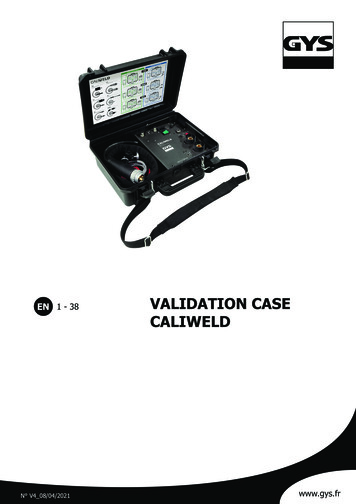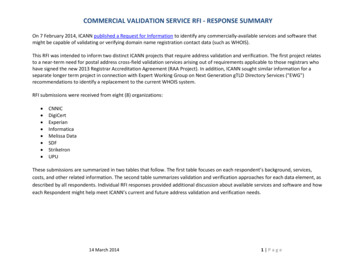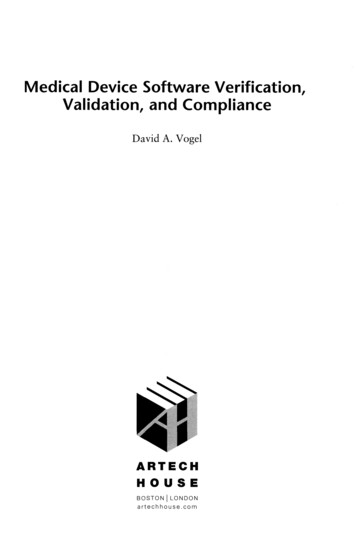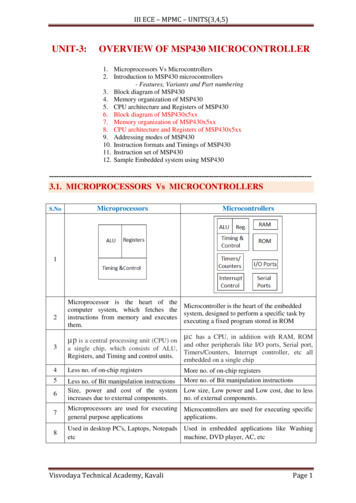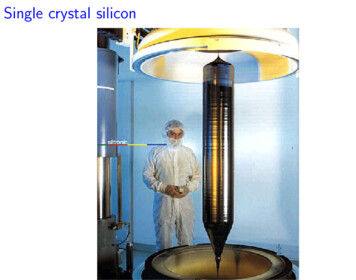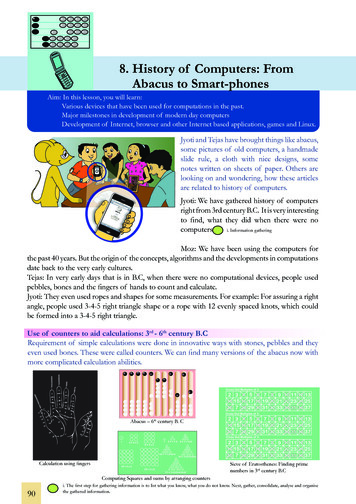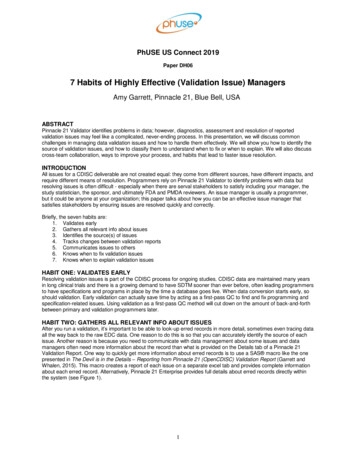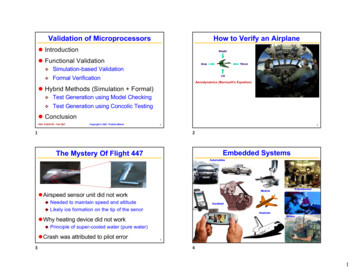
Transcription
How to Verify an AirplaneValidation of Microprocessorsl Introductionl Functional ValidationvSimulation-based ValidationvFormal VerificationAerodynamics (Bernoulli's Equation)l Hybrid Methods (Simulation Formal)vTest Generation using Model CheckingvTest Generation using Concolic Testingl ConclusionCDA 4102/5155 – Fall 2021Copyright 2021 Prabhat Mishra1122Embedded SystemsThe Mystery Of Flight 447AutomobilesMedicallAirspeed sensor unit did not workNeeded to maintain speed and altitudeu Likely ice formation on the tip of the senoruHandheldAirplanesMilitarylWhy heating device did not workuPrinciple of super-cooled water (pure water)lCrash was attributed to pilot error3Entertainment341
Example: BMW 745iExample: Digital CameraMemoryControllersInterfacel 2, 000, 000 LOCl Windows CE OSSoftwarel 53 8-bit µP(Application Programs)Coprocessorsl 11 32-bit µPProcessorl 7 16-bit µPASICl Multiple NetworksConvertersAnalogl Buggy!DigitalAnalog56Ariane Rocket ExplosionElectronic Devices in AutomobileslJune 4, 1996: Ariane 5 rocket explosion.lCost: 7 billion (des), 500 million rocket.lSoftware error in the inertial reference system.uA64 bit floating point number relating to thehorizontal velocity of the rocket with respect to theplatform was converted to a 16 bit signed integer.The number did not fit, and conversion failed.8782
Intel FDIV BugThe MARS Pathfinder ProblemlRare scenario when floating-point division failslDec 1994 / Jan 1995lCost: 475 millionl A few days into the mission, not long afterPathfinder started gathering meteorologicaldata, the spacecraft began experiencing totalsystem resets, each resulting in losses of data.lThe press reported these failures in termssuch as "software glitches" and "the computerwas trying to do too many things at once".” 9910Verification ComplexityStatisticsUp to 70% effort (time and resources)spent on validation and verificationAdder2 32-bit inputs è232 x 232 264 input vectors 1.8 x 1020Adder è1111ALU èProcessor è Systems12123
Design ComplexityUse of Silicon PowerSource: Intel1314Technology and DemandTime-to-Market#of transistors are doubling every 2 years 1 yearTechnologyDemandExplorationPlanning3-4 yearsDevelopmentProductionProduct TimelineCommunication, multimedia, entertainment, networkingDesign complexity è verification complexity15164
Functional Validation of ProcessorsMythical Man-MonthlFunctional validation is a major 516190Pre-silicon logic bugs per generationTeam237855Months until completionIndividual102030Number of designers25000( Source: Tom Schubert, Intel, DAC 2003)182443pipelined complex microarchitectures8002240PentiumPentium ProPentium 4Next ?40lLogic bugs increase at 3-4 times/generationuBugsincrease (exponential) is linear with designcomplexity growth.1718Pentium 4 Bugs BreakdownNorth America Re-spin StatisticsSource: Bob Bentley, HLDVT 20021st Silicon Success100%48%199944%200239%2004Source: 2002 Collett International Research and SynopsysMicro-architectural complexity is a major contributor19205
North America Re-spin StatisticsDesign Validation Complexity48%199944%Engineer Years1st Silicon 110B201995100M20041M10M100MSimulation Vectors20000?BillionsLogic GatesSource: 2002 Collett International Research and Synopsys71% SOC re-spins are due to logic bugsSource: Synopsys2122OverviewlSpecification: capture the design conceptusing SystemC or HDL at appropriate level ofabstraction e.g., behavioral, structural, RTL, uuValidation of Microprocessorsl Introductionl Functional ValidationDesign Verification: is this what I want?lImplementation: Use synthesis tool (or handwritten) to generate lower level of abstractionImplementation Verification: does implementationsatisfies the specification?Simulation: validate the design model using testsu Formal Methods: prove properties or equivalenceuvSimulation-based ValidationvFormal Verificationl Hybrid Methods (Simulation Formal)lVerification Techniques2322vTest Generation using Model CheckingvTest Generation using Concolic Testingl Conclusion24246
SimulationclockComb.LogicStateLoading / Compilation TimeAbstractionStateSimulation elerationCompiled SimulationInterpretive Simulation(transistor level)Performance25Simulation Performance26Validation TechniqueslInterpretive SimulationuLine-by-linesimulation of the HDL codeq Can be functional or cycle-accuratelCompiled SimulationuGenerateC/C equivalent of each line of the HDLcode, compile the equivalent code along withsimulation kernel.Interpretive ISA Simulationl ( ) Simplel ( )Flexibleu Can handle selfl (-)lAccelerationSlowInstructionequivalent code and distribute amongvarious computation nodes e.g., IKOS boxmodifying ationuUsereconfigurable fabric for better performanceand enable validation in the presence of OS etc.27Run TimeEg. SimpleScalar287
Static Compiled Simulationl ( ) DoingTargetApplicationBinarySimulationCompilerul ( )uValidation of Microprocessorsas much as possible at compile timeE.g. No decode at run timel Functional ValidationGenerates fast optimized codeUtilizing compiler optimizationsCompile time overhead & limitation(-) Staticl (-)luCan not handle self modifying codeHostApplicationBinaryCompile TimeExecuteHostvSimulation-based ValidationvFormal Verificationl Hybrid Methods (Simulation Formal)DecodedProgramCodeGenerationl IntroductionE.g:[Zhu95][Braun01]Run TimevTest Generation using Model CheckingvTest Generation using Concolic Testingl Conclusion302930Formal VerificationWhat is Theorem Proving?l Solving by combinatorial enumeration and searchl Given RuleslTheorem ProvinguProve a theorem about the system correctnessl Model CheckinguCheck whether design satisfies a propertyl Equivalence CheckinguSimulate the design using symbolic inputs31Find a satisfiable assignment: parent(X,Y), male(X).mother(X,Y): parent(X,Y), female(X).usibling(X,Y): parent(Z,X), parent(Z,Y).ugrandparent(X,Y): parent(X,Z), parent(Z,Y).uuncle(X,Y)u: parent(Z,Y), sibling(X,Z), male(X).male(john), male(sam), male(joe), male(bill), female(sue),female(ellen), parent(sam, john), parent(ellen, john), parent(ellen, joe),parent(sam, joe), parent(sue, bill), parent(al, sam), parent(sue, ellen).l Queryl Satisfiability (SAT) Solvingufather(X,Y)ul FactsCheck whether two designs are equivalentl Symbolic Simulationuuu uncle(bill,john)?john)?u uncle(sue,31yes.fail.328
Use of Theorem ProvingFormal VerificationlTheorem ProvinglDrive Rules from SpecificationlState the Theorem about the correctness ofthe ImplementationlProve the TheoremlExplore the use of PVS theorem proveruuProve a theorem about the system correctnessl Model CheckinguCheck whether design satisfies a propertyl Equivalence Checkinghttp://pvs.csl.sri.com/uCheck whether two designs are equivalentl Symbolic SimulationuSimulate the design using symbolic inputsl Satisfiability (SAT) Solvingu3333Find a satisfiable assignment3434Model CheckingFormal VerificationlTheorem ProvingModel(System em Property)Yes, if model satisfiesthe specificationNo, Counterexampleul Model Checkingumodel satisfied enough system propertiesu Study counterexamples, pinpoint the source of the error,correct the model, and try againl Explore the use of SMV model checkeru http://www.kenmcmil.com/smv.htmluCheck whether two designs are equivalentl Symbolic SimulationuSimulate the design using symbolic inputsl Satisfiability (SAT) Solvinguu http://www.cs.cmu.edu/ modelcheck/smv.html35Check whether design satisfies a propertyl Equivalence Checkingl Increase confidence in the correctness of the model:u TheProve a theorem about the system correctnessFind a satisfiable assignment36369
What is Satisfiability (SAT)?Use of SAT for VerificationlModel the design in CNFlModel the property in CNFlCheck the satisfiability of the overall CNFlExplore the use of zChaff SAT solverGiven a propositional formula in CNF,find if there exists an assignment toBoolean variables that makes theformula true:literalsuhttp://www.princeton.edu/ chaff/zchaff.htmlw1 (b Ú c)clausesw2 ( a Ú d)w3 ( b Ú d)j w1 Ù w2 Ù w3SATisfyingassignment!A {a 0, b 1, c 0, d 1}383738Formal VerificationSimulationln-input NAND gate requires 2n vectorslTheorem ProvinguProve a theorem about the system correctnessInputsl Model CheckinguCheck whether design satisfies a propertyl Equivalence CheckinguCheck whether two designs are equivalentSimulate the design using symbolic inputsl Satisfiability (SAT) Solvingu39Find a satisfiable assignment00111011101lTernary simulation requires n 1 vectorsl Symbolic SimulationuOutput00X1X01110394010
Symbolic SimulationProperty Checking: An ExampleCA0BX1X01110Antecedentl PowerPC Memory Management Unitl Three blocks and many sub-blocksuuuConsequentl Each sub-block uses RAMAB( 0, X ) 1Segment registersBlock Address Translation (BAT)Translation Lookaside Buffer (TLB)CuConsequent: (C is (a &b) from 1 to 2)Entry 1data1paeavalid0always @ (wrClk or wrEn or dIn or wrAddr)beginif (wrClk & wrEn) ram[wrAddr] dIn;endLRUValid 1Antecedent: (A is a from 0 to 1) and (B is b from 0 to 1)data0Entry 0assign out (rdClk & rdEn) ? ram[rdAddr] : 32’b0;l Property for writeuvsidValid 0lRequires only 1 vectorl Property for readvalid1TLBl Same property can be used for all sub-blocksu41Name mapping needed42Property Checking: Experimentsl TLB miss detectionuuuuuuassign input assign out0 assign out1 assign hit0 assign hit1 assign miss ( {1'b1, vsid[0:23], ea[4:9],ea[10:13] } );( {valid0, data0[0:23], data0[24:29], data0[54:57]} );( {valid1, data1[0:23], data1[24:29], data1[54:57]} );( input out0 );( input out1 ); ( hit0 hit1 );Formal VerificationlTheorem Provingul Model CheckinguvsidEntry 0data0Entry 1data1LRUValid 1Valid 0valid0uvalid1TLBl Applicable to BAT array miss detectionl Simple extension for associativity nCheck whether two designs are equivalentl Symbolic SimulationuSimulate the design using symbolic inputsl Satisfiability (SAT) Solvingu43Check whether design satisfies a propertyl Equivalence CheckingpaeaProve a theorem about the system correctnessFind a satisfiable assignment444411
Equivalence Checking: An ExampleEquivalence Checkingl Traditional Equivalence Checkersl Equivalence Checking using SAT SolversInputsSpecificationOutputl Reference: generated from ADL specificationl Implementation: 32-bit RISC DLX (eda.org)l Equivalence Checker: Synopsys Formalityl Experimentsu Identified a bugu Validation time:XORImplementationin computation of overflow397 secondsl Limitationu reference model generation needs to be guidedq to maintain structure similar to the implementationl Works well between industrial RTL andgate-level designs (why?).454546Simulation-based ValidationValidation of Microprocessorsl IntroductionTestGenerationl Functional ValidationvSimulation-based ValidationvFormal VerificationTestsTestTestTestSimulation(DUT)Pass /FailCoverageAnalysisl Hybrid Methods (Simulation Formal)vTest Generation using Model CheckingvTest Generation using Concolic TestinglSimulation-based validation is widely usedUses billions to trillions of random testsu Still no guarantee of covering important scenariosul Conclusion47474812
Why Directed Test Generation?Test Generation for Functional ValidationAATest GeneratorPipelined DIVFADD3MUL7Random TestMOV R1, 011DecodeBBTestGenMemoryDirected TestADD R3, R1, R2# R3 101Test ProgramFADD4DecodelSignificantly less number of directed tests canachieve same coverage goal than random testsMOV R2, 010WriteBackR3 101 ?Check ResultVerifies the functionality of the processor using assembly programslNeed for automated generation of directed tests4950Validation of MicroprocessorsTest Generation using Model CheckingExample: Generate a directed test to stall a decode unit (ID)Negated PropertyDesign(intended behavior)assert G (ID.stall ! 1)Processor Modell Introductionl Functional ValidationModel CheckerCycle123Opcode Dest Src1 Src2NOPADDR3R1 R2SUBR4R3R2Counter example (directed test)51Simulation-based ValidationvFormal Verificationl Hybrid Methods (Simulation Formal)Solution: Exploit learning to reduce test generation complexityProblem: Test generation is time consuming and may not beTest whenModelCheck(Design& Property)possiblecomplex designand propertiesare involved 51vvTest Generation using Model CheckingvTest Generation using Concolic Testingl Conclusion525213
Why 100% coverage is hard to reach?Functional ValidationNested branches: Nested branches lower the probability of being hit byrandom test vectorsFunctionalCoverage100% Statement coverage – 100% Branch coverage – 90% Path coverage – 80%If (rare branch) {(statements)If (rarer branch) {(statements)If (rarest branch) {101001k10k100k}1m}# Test vectors}5354Why 100% coverage is hard to reach?Nested branches: Nested branches lower the probability of being hit byrandom test vectorsalways @(posedge clock)beginif (input 0 && State D)State AIf (input 1 && State C)State BIf (input 2 && State A)State CIf (input 3 && State B)State D(more branches)endalways @(posedge clock)beginif (input 0 && State C)out 128If (input 1 && State A)out 127If (input 2 && State D)out 126If (input 3 && State B)out 125(more branches)endConcurrency: Concurrently running blocks increase the complexity55Why 100% coverage is hard to reach?Nested branches: Nested branches lower the probability ofbeing hit by random test vectorsalways @(posedge clock)beginif (reset)State 0else if (input 1)State State 1elseState State - 1endalways @(posedge clock)beginif (reset)Trig 0If (State 32’hABCD)Trig 1(more branches)endConcurrency: Concurrently running blocks increase thecomplexity𝑁!" iteration: Branches that can only be activated aftermillions of iterations5614
Related Works on Concolic TestingTest Generation Techniquesl Manual Test Writingl Random TestGenerationuSmall design – DoableuLarge design - HarduLarge designs – ScalableuRTL designs - Harder(Concurrency, multiple clockdomains, etc.)uNo guarantee of fullcoveragel Formal MethoduuSmall design – EfficientLarge design – State explosionSoftware designs:RTL designs:l Symbolic Backward Executionl Uniform Concolic Testingu Chandra et al., SIGPLAN, 2009u Charreteur et al., ISSRE, 2010u Dinges et al., ASE, 2014l Semi-Formal Method(Concolic Testing)ul Directed Concolic Testingu Burnim et al., ASE, 2008Large design – Scalableand Effectivel Ahmed et al., ICCD 2017l Directed Concolic Testingu Liu et al., TODAES 2014u Ahmed et al., DATE 2018u Lyu et al., TC 2020u Zamfir et al., EuroSys, 201057575858Concolic TestingConcolic TestingCombines concrete and symbolic executionCombines concrete and symbolic executionI1CFG of PStartStart t. pathb2b4Exitb5 b2SimulateSolveSymbolicallySelectalt. pathb2 b4b4Exit b5b5 b2 b3b35959GenerateInput b3b3 b1b1 b4 b5606015
Concolic TestingConcolic TestingCombines concrete and symbolic executionCombines concrete and symbolic executionI1I1StartStart t. pathb1 t. path b3b3 b3 b4b4b2𝑐 𝑏! 𝑏" 𝑏#Exitb5Exit b561616262Top-Down Validation ApproachConcolic TestingCombines concrete and symbolic executionArchitecture Specification(English Document)I2StartSpecification b1b1GenerateInputSimulateb2Abstracted b2DesignSelectalt. pathb6ImplementationntioacstrAb b3b3SolveSymbolically b6𝑐 𝑏! 𝑏" 𝑏#TransformRTLExitb7 b7SimulationFormalVerificationModel CheckingModified DesignDesign(RTL / Gate)Equivalence CheckingManual Process63636416
ConclusionlFunctional validation is a major bottlenecklTo verify large designs, industry uses anefficient combination of simulation-basedtechniques and formal methods.uSimulation-basedTechniquesqMost widely used form of validationqCannot achieve the completeness of verificationlFormal MethodsuCompleteverification by using mathematical proofq theorem proving, model checking, equivalencechecking, symbolic simulation or statisfiability solvinguAppliedonly to small and critical components6517
lEquivalence Checker: Synopsys Formality lExperiments uIdentified a bug in computation of overflow uValidation time: 397 seconds lLimitation ureference model generation needs to be guided qto maintain structure similar to the implementation 46 47 Validation of Microprocessors lIntroduction lFunctional Validation vSimulation-based Validation
